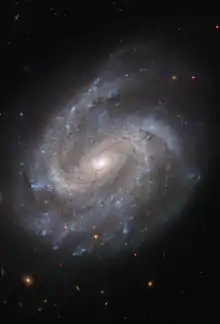| NGC 201 | |
|---|---|
 Hubble Space Telescope image of NGC 201 | |
| Observation data (J2000 epoch) | |
| Constellation | Cetus |
| Right ascension | 00h 39m 34.820s[1] |
| Declination | 00° 51′ 35.60″[1] |
| Redshift | 0.014728 +/- 0.000062 [1] |
| Heliocentric radial velocity | 4415 +/- 19 km/s [1] |
| Galactocentric velocity | 4505 +/- 19 km/s [1] |
| Distance | 61.7 ± 4.3 kpc (201 ± 14 kly)h−1 0.73 [1] |
| Apparent magnitude (V) | 13.8 [1] |
| Characteristics | |
| Type | SAB(r)c [2] |
| Apparent size (V) | 1.8' x 1.5' [2] |
| Other designations | |
| PGC 2388, UGC 419, MCG +00-02-115, HCG 007C | |
NGC 201 is a spiral galaxy in the constellation of Cetus. It is one of the group members of HCG 7, with the other group members NGC 192, NGC 196, and NGC 197. It was discovered on December 28, 1790 by William Herschel.[2]
One supernova has been observed in NGC 201: SN 2019yc (type IIb, mag. 16.7).[3]
See also
Image gallery
References
- 1 2 3 4 5 6 7 "NASA/IPAC Extragalactic Database". Results for NGC 201. Retrieved 2015-09-04.
- 1 2 3 "New General Catalogue Objects: NGC 200-249". Retrieved 2015-09-04.
- ↑ Transient Name Server entry for SN 2019yc. Retrieved 24 March 2023.
External links
 Media related to NGC 201 at Wikimedia Commons
Media related to NGC 201 at Wikimedia Commons- NGC 201 on WikiSky: DSS2, SDSS, GALEX, IRAS, Hydrogen α, X-Ray, Astrophoto, Sky Map, Articles and images
- SEDS
This article is issued from Wikipedia. The text is licensed under Creative Commons - Attribution - Sharealike. Additional terms may apply for the media files.

